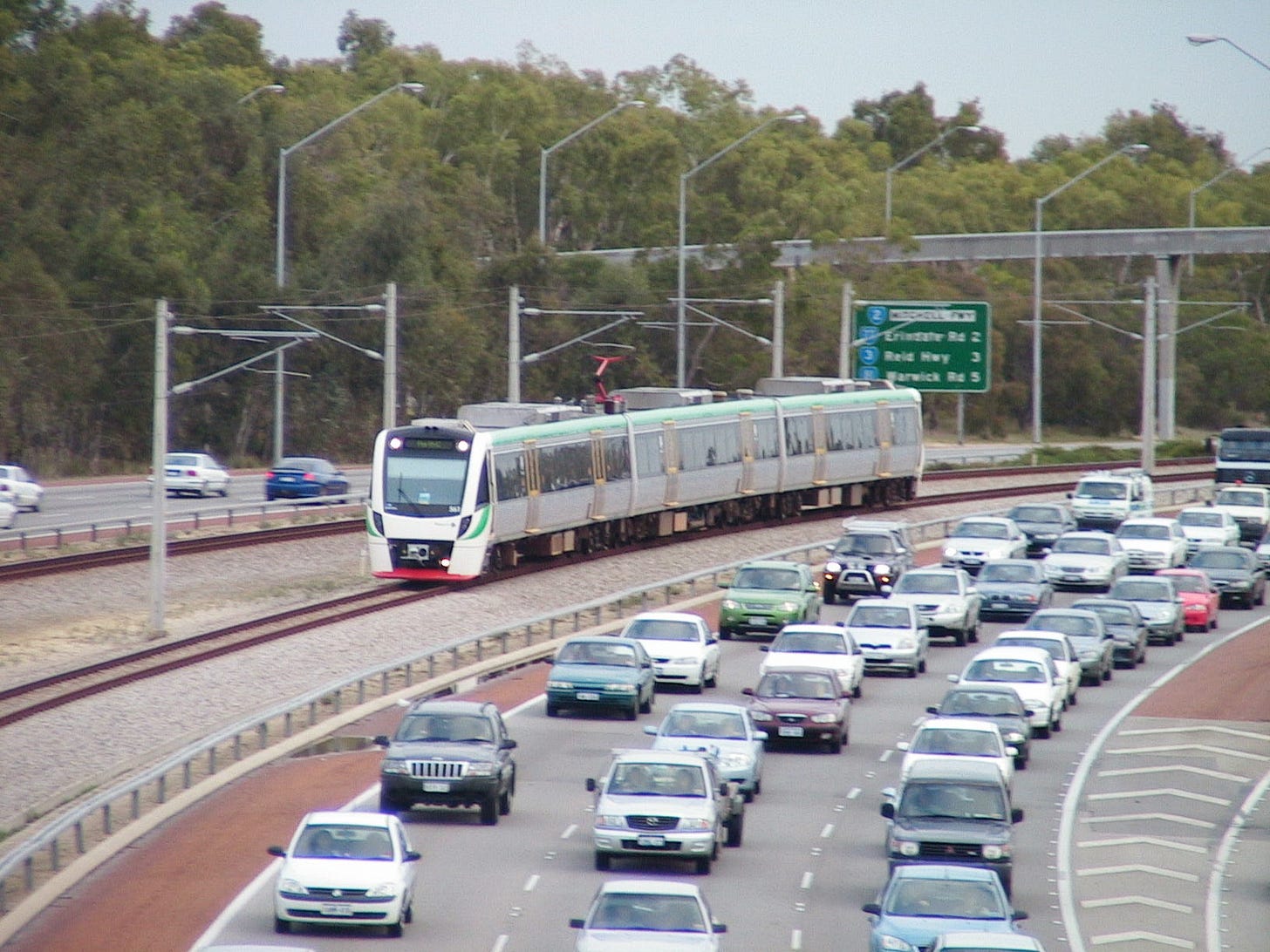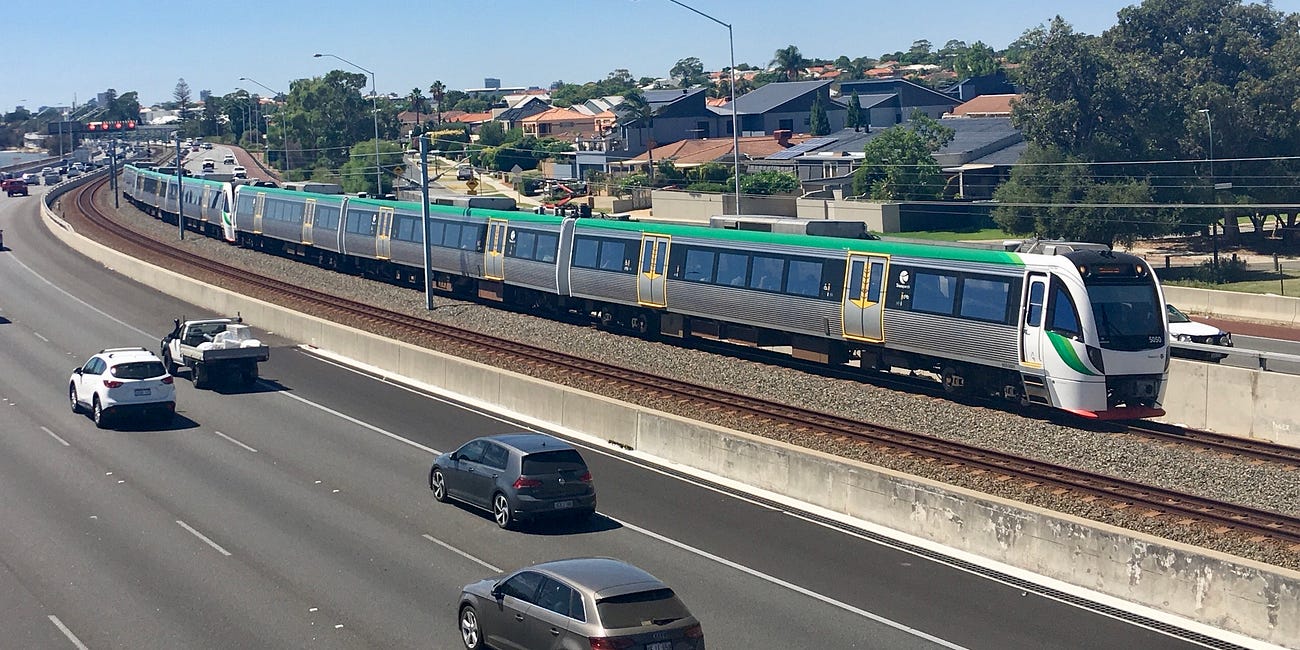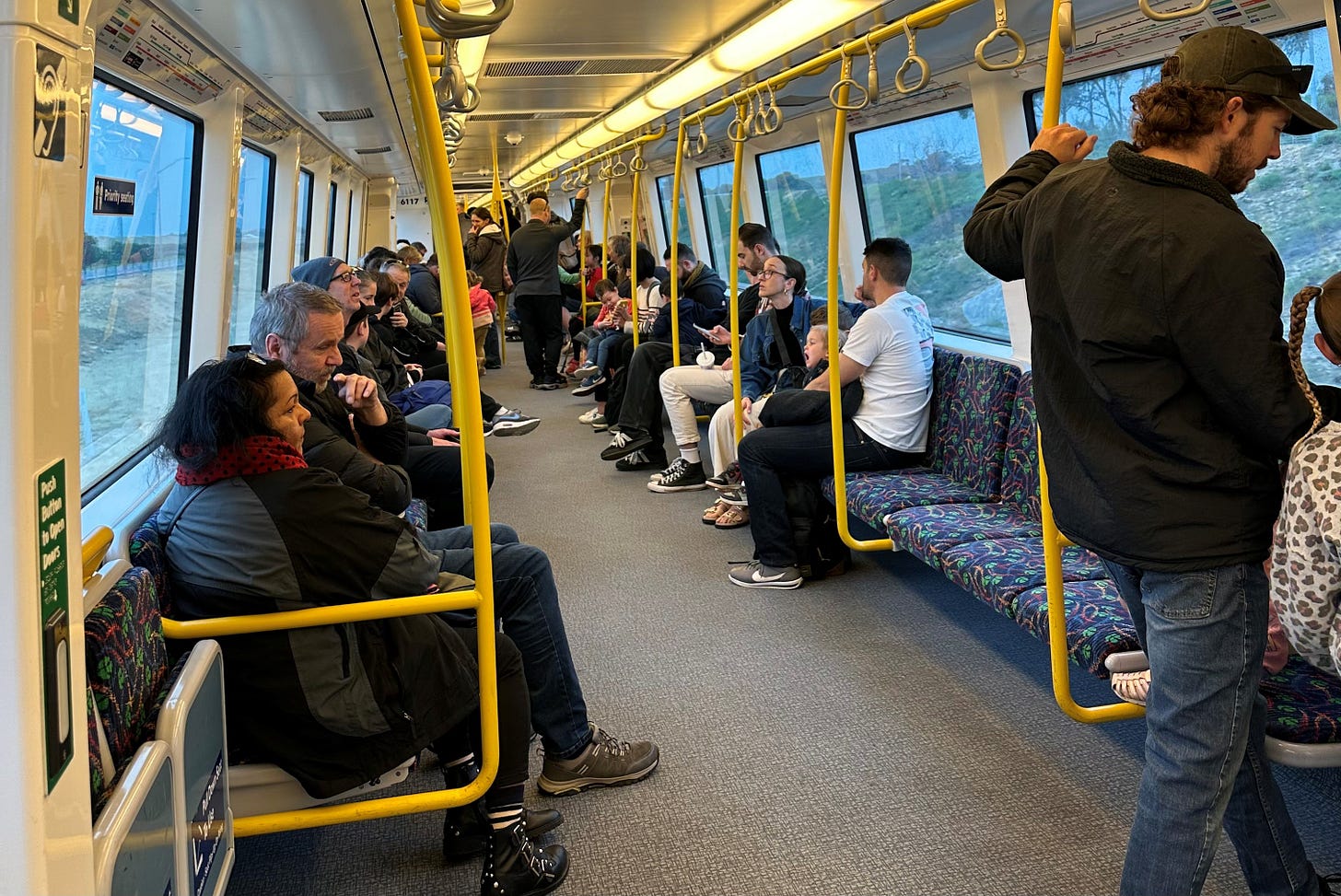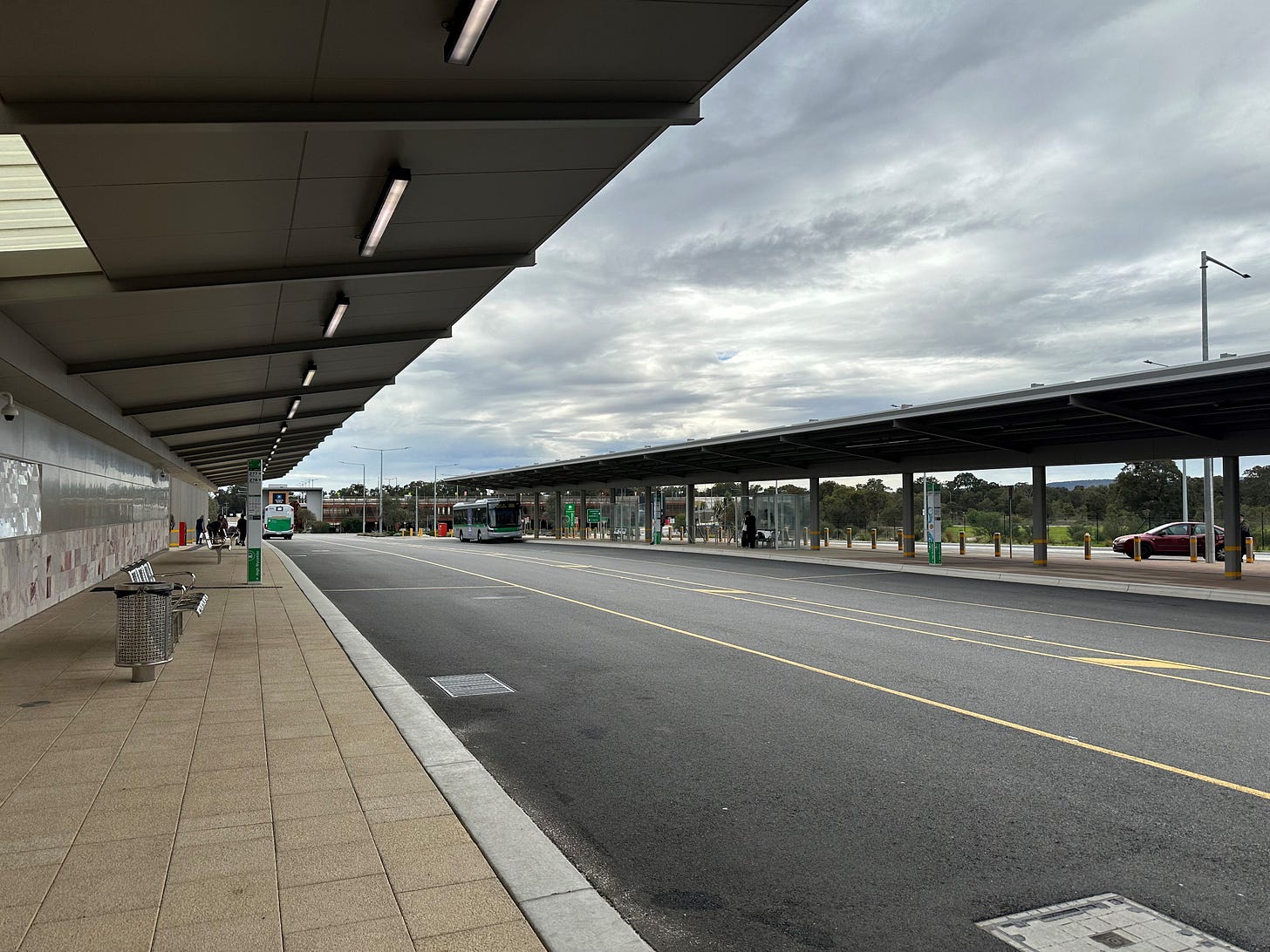Nine public transport lessons from Perth
Perth is a very sprawly, low-density, car-oriented city. Yet it has great public transport. What follows are nine lessons we can take from Perth in order to make public transport great anywhere.
A while ago, I did a piece on Perth’s public transport journey, outlining how Perth got to where it is now. I recommend reading this piece if you haven’t already as it sets the context for this piece. See below.
Perth's Rail Journey - from (near) zero to hero
Perth, population 2.1 million, sits on the Indian Ocean and is the capital city of the mineral-rich state of Western Australia which is literally bigger than Texas. Three times bigger in fact. And like Texan cities, Perth sprawls. Seriously sprawls. It stretches more than 120 kilometres from north to south. There is a major and still developing motorway…
In this piece, I will drill into some of the key ways Perth makes public transport work in a city that has many of the pre-requisites to create a public transport desert.
1. Public transport for everyone
One way to see how well public transport works for a city is to look at who is making most use of it. Cities that have coverage focused base accessibility networks at low frequencies tend to have a public transport customer base of people who have to use public transport, not people who choose to use public transport.
In Perth’s case, it’s clear that the public transport demographic is unusually broad for a very car-oriented city. Passengers at all sorts at different times of day and days of the week make use of the network as in the image below.
2. Accessible public transport
It’s a simple truth that making public transport fully accessible both maximises the number of people who can use public transport as well as making public transport easier to use for everyone, including those with accessibility challenges. Accessibility is a win-win for everyone, not a “nice to have” for those who have accessibility challenges.
All trains on the Perth rail network have full level boarding for the whole length of train. Equally, all train station platforms are entirely flush with the level of the train doors. All buses are accessible as are nearly all bus stops. In Australia, this is legally mandated through the Disability Discrimination Act, noting that every state is behind on meeting the deadline for fully accessible surface public transport.

While this is interesting and worthy in its own right, what is more important is what it enables. Which is independent, dignified access to trains for people who use a wheelchair. The situation with buses is similar to analogous cities where the bus driver needs to deploy a manual ramp in order for people using a mobility device to be able to board. While this means a fully accessible bus system, it lacks the added dignity provided by trains which can be boarded independently.
3. A focus on simplicity and legibility
A basic principle of public transport planning is simplicity, legibility and consistency. Perth does this well through simple, consistent clock face timetables (where services operate at the same time each hour) and consistent service spans. The KISS (Keep It Simple Stupid) principle applies here. The mental load needed to use public transport should not be a mental drain.

4. A focus on frequency
To repeat Jarrett Walker’s off-repeated refrain, “frequency is freedom.” A measure of this freedom is how much of a city you can reach within a reasonable travel time, rather than an obsession on point to point travel at peak times to the urban core. And in frequency, Perth generally does a pretty good job.
For example, entire Perth rail network runs at least every 15 minutes all day, every day of the week and at a significant number of stations on the legacy lines served by two lines, this further improves to a train every 7.5 minutes, all day every day of the week.

And it’s not only trains but buses that deliver frequency in Perth. The high-frequency bus network does a lot of frequent heavy lifting in non-rail served parts of Perth. There are 15 high-frequency 900 series bus routes in Perth. These services run at least every 15 minutes between 7am and 7pm on weekdays, 8am and 7pm on Saturdays, and 9am and 7pm on Sundays. While this is good, it’s not great. Auckland, which is smaller than Perth, has just implemented its 40th frequent bus route running at least every 15 minutes, 7am to 7pm, 7 days a week, with more frequent routes in the pipeline.
While there are frequent trains, these often connect to less frequent feeder buses at stations. While services are time-integrated between bus and rail, any delay to either bus or rail journey can mean a missed connection and long waits.

A focus on speed
Visible public transport speed, particularly speed visible to car drivers stuck on congested barely moving motorways, is some of the best free self-marketing for public transport around. And Perth has this with the Yanchep Line running in the median of the Mitchell Freeway and the Mandurah Line running in the median of the Kwinana Freeway.

This is supported by high speeds on the newer lines on the Perth rail network - the Airport, Yanchep and Mandurah lines - which each have a top speed of 130 kilometres per hour and wide station spacing. The legacy lines - Armadale, Thornlie and Midland - have a top speed of 100 kilometres per hour while the Fremantle line has a top speed of 90 kilometres per hour.
Good travel speeds is matched by excellent dwell time management at stations which in itself is abetted by level boarding the entire length of the train and platform. Overall, the sense you get as a passenger is that your time is not being wasted on trains in Perth. The same applies for those (few) bus routes in Perth where there is bus priority, but noting that this is an area where Perth could do much better.
6. A focus on safety
Like elsewhere in Australia and the world, anti-social behaviour on public transport in Perth is an emerging issue, especially at night. But unlike most jurisdictions, Transperth tracks perceptions of public transport at night and actively works to improve passenger safety.

Part of this is focusing presence of authorised officers on all trains and bus routes with known behavioural issues from 7:30pm, subject to staff availability. But another part of this is the high usage of public transport at all times along with well-presented buses and trains in themselves acting as a deterrent to anti-social behaviour.
7. A focus on presentation
The presentation of the entire public transport network is nothing short of spotless. And, incredibly, this includes a rail network that is completely clear of graffiti, even along the rail corridors. Buses and depots are owned by Transperth and strict contract condition enforcement means that buses and trains keep that “new train” and “new bus” look long after entering service. The overall impression this leaves is of good stewardship of the network that residents and visitors to Perth alike can be proud of.
8. An integrated network
Perth’s public transport operates as a network, not a collection of modes and services. This is particularly evident at train stations where bus interchanges are an integral part of the stations and bus interchanges are future-proofed with future network development in mind.
In the photo of the High Wycombe Station bus interchange looks deserted, the area around is only just starting to develop and the interchange is designed with the future bus network in mind. On top of this, buses pulse around the 15-minute train frequency so the station looks (and is) deserted between these pulses.
9. No irritating train announcements
Possibly not the most important element but a particular bugbear of mine is repetitive, redundant, infantilising and plain irritating on-board automated train announcements. With a particularly intense disdain for “train etiquette” announcements telling people stuff they already know, and some choose to ignore.
Perth keeps train announcements to the bare minimum of next station and station arrival announcements, making for journeys not frequently interrupted by superfluous and often self-evident announcements.
Final thoughts
Perth has transitioned from a poor public transport performer three decades ago to third place in Australia in public transport patronage per capita.
This is because it has acknowledged that it is working with a very sprawly, low-density, car-oriented city to make public transport work for that context. And in doing so, it has avoid the trap of what I call CAT (Car Oriented Transit), the sort of public transport that requires a car to access it, focused on park and ride as the privileged and prioritised access mode. This works to reinforce rather than relieve car dependency. While it does have this usual strong Australian focus on park and ride, it also provides good feeder bus networks (that admittedly could do with more frequency in outer areas) to bus interchanges well-integrated with rail stations, which prioritise feeder bus access over park and ride access.
And most importantly Perth understands that accessibility, frequency, simplicity, frequency, speed, safety and presentation are all key elements that need to work together as a whole to make public transport work as a whole.








